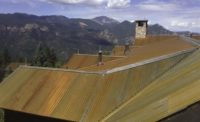Benjamin Franklin did his seminal work on lightning protection while living in Philadelphia. It is not surprising then that the Philadelphia Museum of Art honors its home-town hero with two lightning-related artworks. The first hangs on a Museum wall — the iconic painting of Franklin’s kite-flying experiment. The second is on its roof — a new lightning protection system (LPS) based on Franklin’s time-tested discoveries. While few visitors notice the system, its craftsmanship raises it to the level of art.
The lightning protection was installed as part of a major restoration of the Museum’s exterior, built in 1928. Limestone walls and terracotta ornaments were cleaned and repaired and, to prevent further water damage, approximately 2,000 feet of stainless steel gutters and a new roof drainage system were installed.
The decision to install lightning protection is in accordance with risk assessment guidelines in National Fire Protection Association (NFPA) Standard 780 - Standard for the Installation of Lightning Protection. It states, “There are some cases where the need for protection should be given serious consideration regardless of the outcome of the risk assessment,” including, “buildings containing irreplaceable cultural heritage.”
According to Bob Gumaer, Vice President of Warren Lightning Rod Company, “We had to design and install a system that is compatible with the building’s architectural elements and preserves the historic fabric of the landmark building.” Lead by individuals certified as Master Installers/Designers by the Lightning Protection Institute, the team was up to the challenge.
NFPA requires air terminals (what Franklin called, “lightning rods”) to rise at least 10 inches above rooftop projections such as the 22-inch tall antefixes — the upright ornaments at the eaves. Air terminals long enough to satisfy the project’s geometry would require bracing, and the Museum would not allow air terminals to be fastened to the fragile terracotta. Warren Lightning Rod resolved the requirements by mounting air terminals on stainless steel pedestals welded to the new gutters. The pedestals are installed up to 24 inches back from the roof edge, and air terminals are angled so only their tips extend to the roof edge. Gumaer states, “The slender air terminals are hardly visible from the ground. Made of copper, they will weather to blend into the dark roof tiles.”
Bronze sculptures — known in Classical architecture as “acroteria” and typically mounted on the apex and corners of pediments — were put to work as “strike termination devices.” Jennifer Morgan, co-owner of East Coast Lightning Equipment Inc., the manufacturer of LPS components used on the building, explains, “NFPA allows building and structural elements to be used as alternatives to conventional air terminals if they are at least 3/16-inch thick metal and electrically continuous with the lightning protection system.”
The corner acroteria are griffins—half lion and half eagle—and mythologically symbolize the power to protect a treasure. How appropriate, then, that they are used in the lightning protection system that protects the Museum and its treasures.













